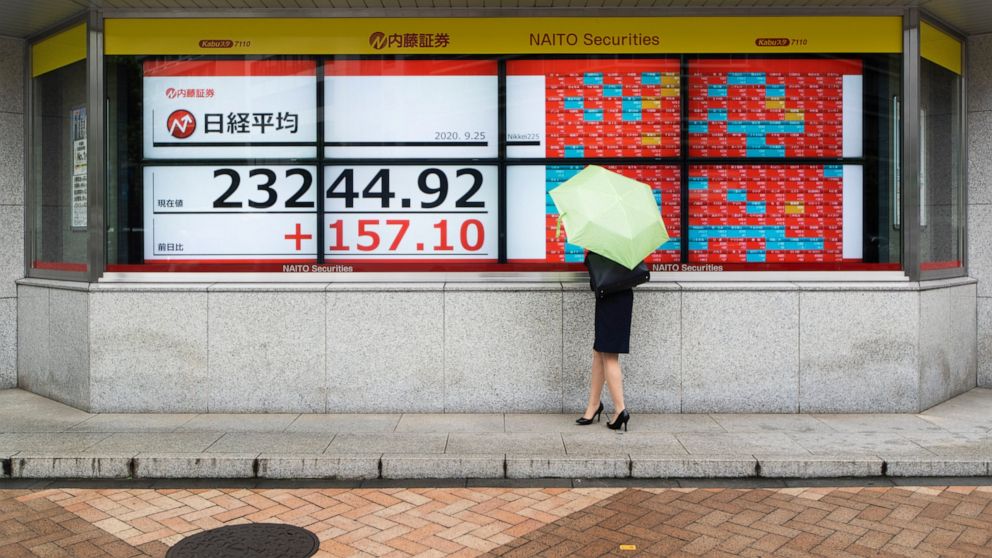US stocks are mixed as S&P 500 heads for 4th weekly loss
U.S. stocks are wobbling in early Friday trading, as the S&P 500 heads for a fourth straight week of losses amid Wall Street’s sudden September swoon
NEW YORK — U.S. stocks are wobbling in early Friday trading, as the S&P 500 heads for a fourth straight week of losses amid Wall Street’s sudden September swoon.
The S&P 500 was 0.1% lower after flipping from a loss to a tiny gain and back within the first few minutes of trading. Stocks have been erratic recently, and indexes have taken several sharp turns in momentum each day. The S&P 500 is still on pace for a loss of 2.3% this week, which would give the index its first four-week losing streak in more than a year.
The Dow Jones Industrial Average was down 41 points, or 0.2%, at 26,775, as of 9:53 a.m. Eastern time, and the Nasdaq composite was 0.1% higher.
Smaller stocks were faring slightly better and the Russell 2000 index of small-cap stocks was 0.4% higher.
Stocks have struggled this month amid a long list of concerns. Chief among them is that stocks may have gotten too expensive following their record-breaking run through the summer, after storming 60% higher even as the economy continued to struggle under the pandemic. Critics say Big Tech stocks in particular rose too high, even after accounting for their tremendous growth.
Big Tech stocks were mixed in early Friday trading, with Apple up 0.4, but Amazon down 0.2% and Microsoft down 0.2%.
Recently, investors’ frustration has also grown with the inability of Congress to deliver more aid to the economy after weekly unemployment benefits and other stimulus expired.
Democrats in the House of Representatives are paring back their proposal for stimulus in hopes of jumpstarting talks with the White House, but investors are skeptical something can happen soon. Deep partisan divisions have kept Congress from acting, and tensions are on the rise due to the sudden vacancy on the Supreme Court following the death of Justice Ruth Bade Ginsburg.
President Donald Trump has also declined to guarantee a peaceful transfer of power if he loses the upcoming election, though other Republicans have pushed back on that idea.
“This stimulus deal needs to go through,” Stephen Innes of AxiCorp said in a commentary. “With the risks building up everywhere you look, it doesn’t seem to be a great time to be trying to pick the bottom of equity markets, but a stimulus relief bill will go a long way to nudging the market along.”
Among other concerns for markets are rising tensions between the United States and China and the possibility that investors’ expectations for a COVID-19 vaccine arriving early next year may prove to be too optimistic.
Novavax rose 4.8% after it said it began a late stage trial of its potential COVID-19 vaccine in the United Kingdom.
On top of all the market’s concerns are the pandemic and worries that worsening trends could lead to more profit-choking restrictions on businesses.
All those concerns have helped push the S&P 500 down more than 7% this month, following up on five straight months of strong gains.
Investors pulled $22.8 billion out of stock funds in the week ending Sept. 23, the largest outflow since March, according to a BofA Global Research report.
Wall Street’s rally started in late March after the Federal Reserve and Congress pledged massive amounts of support for the economy. Budding economic improvements later in the spring helped accelerate the gains as widespread shutdown orders lifted.
The Fed has pledged to continue to hold short-term rates at nearly zero for years, but its chair Jerome Powell said repeatedly in testimony on Capitol Hill this week that the recovery will likely need more help from Congress as well. Growth in some areas of the economy has already slowed due to the expiration of the stimulus from Congress.
In Europe, stocks were also weakening. Germany’s DAX lost 1.6%, and France’s CAC 40 fell 1.4%. The FTSE 100 in London fell 0.1%.
In Asia, Japan’s Nikkei 225 rose 0.5% and South Korea’s Kospi added 0.3%. Hong Kong’s Hang Seng fell 0.3%, and stocks in Shanghai slipped 0.1%.
The yield on the 10-year Treasury dipped to 0.65% from 0.66% late Thursday.
———
AP Business Writer Yuri Kageyama contributed.
![]()


